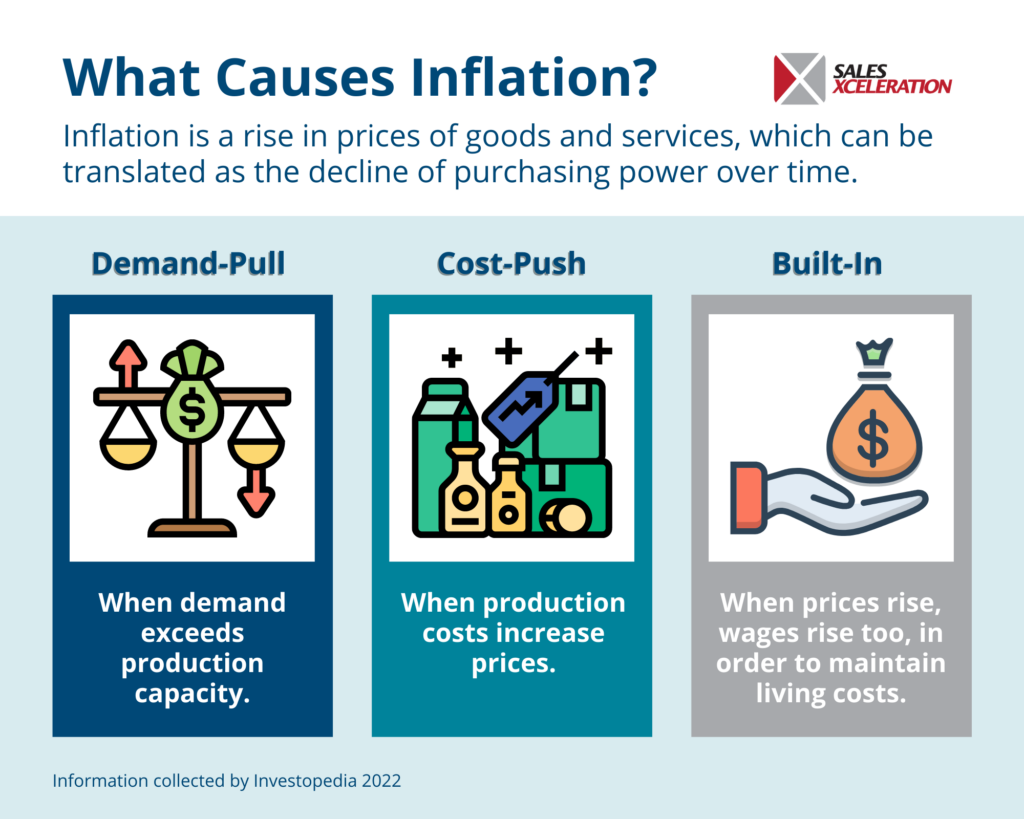
Even in the best economic times, it’s not uncommon for clients and buyers to seek business discounts on your products or service solutions. From their perspective, there can be many reasons to ask for better pricing: lack of perceived value, insufficient funds, better quotes from competitors, and so on. After all, who doesn’t like to get the best possible deal, right? But when economic conditions are less robust, such as during times of high inflation and recession, the expectation for discounting pricing can become amplified, forcing the small to mid-sized business into a corner.
While discounting is tempting in such challenging times, when business and sales professionals accept a lower price, it opens a veritable Pandora’s Box of likely problems that could put the business at risk. Here’s how discounting hurts your business, along with some alternatives that can keep you from sacrificing profit:
Effects of Inflation
First, what is inflation? Inflation is a rise in prices, which can be translated as the decline of purchasing power over time. Investopedia’s article, Inflation: What it is and how it can be controlled, is a great resource on economic inflation.
Second, how does inflation impact a business? And how crippling can a recession be for profits, margins, and outright survival?
In stable economic times, inflation is part of the normal cost of business and is less threatening to business success and survival. However, high and inconsistent rates of inflation can impose major concerns, especially for small businesses.
- Businesses now need to balance their supply with consumer demand
- They need to plan for growing expenses, including higher employee pay
- High supply chain costs could narrow profit margins further
For SMBs, the bottom-line impact of this economic volatility can be much more severe than for larger companies. So, what can the typical SMB do to be prepared and protected against inflation and recession? Our past article, Inflation: How to Prepare and Protect Your Business, provides key strategies to weather economic downturns and challenges.
But one thing most businesses should NOT do without careful consideration is discounting pricing on products and services.

Discounting is Bad for Business
It lessens the perceived (and therefore, actual) value of your product or service.
Simply put, if the customer asks for and receives a discount – regardless of the reason – the perceived value of your solution automatically goes down. An old adage says an item is only worth as much as someone is willing to pay. So, if the price is lower than your claimed value, the actual value can really only match the price paid. And this new belief system can put you in a bad position for future business.
It creates an expectation of future discounting.
Because your earlier discounts have lowered the bar on the perception of value, why should they pay more? Would you? Discounting sets a bad precedent that undermines your future opportunities to maximize margin.
It complicates your business dealings.
When you offer a discount to one customer, but not to another (perhaps because they didn’t push as hard for it), you are suddenly operating under different price structures for likely the same level of service for the same solution. A variety of pricing levels can create internal chaos and administrative nightmares, especially in larger organizations with larger customer bases.
It demonstrates a lack of confidence in your solution and erodes trust in YOU.
This goes back to the idea of value. Even if the customer doesn’t automatically value your solution as you would like, when you start to discount, it shows that you don’t really believe your value proposition either. Prospects sense this lack of confidence and question two things: 1) Is this solution as good as I thought if they are willing to accept less? and 2) Can I really trust this person who wants me to buy it?
It squeezes your profit margin unnecessarily.
Obviously, if you sell a product or service at full price, your margin will be higher than if you sell at a discount. Conversely, the profit margin you lose through discounting has to be made up for in future opportunities, causing you to exert more sales effort and close more deals at a higher price to compensate.
It forces you to cut corners (or at least consider cutting them).
To maintain necessary margins after selling at a discount, it will inevitably prove tempting to find ways to lower your costs – either by reducing material costs or the activities associated with servicing the account. While it is always a good idea to find ways to operate efficiently, if you feel forced to unnaturally lower your costs, you could easily cross a critical line where your perceived value takes yet another hit.
Better Alternatives than Discounting During Small Business Inflation
Are there better responses to inflation and recession for the SMB? Certainly, while customers want to control costs as businesses need to raise prices to battle inflation, overcoming this economic “double whammy” can be challenging. But it CAN be done. Here’s how your business can possibly fend off these negative economic influences:
Emphasize value
The best alternative to discounting is to be crystal clear and confident in presenting your value proposition. Ultimately, it should be irrefutable that the prospect will receive an equitable return on investment. While reaching that awareness, it is reasonable for the prospect to ask questions, offer objections, and seek the best deal. This is all part of their due diligence as they represent their interests. But if you can overcome objections clearly and without hesitation, the value of your solution will become appreciated, and the quoted price will be supportable.
Remember, you have two choices when attempting to equalize price and value – so choose raising value over lowering price. Your customer will “get what they paid for” and you just made more money and avoided long-term issues!
Eliminate components to stay within budget
If budgetary restrictions just can’t allow the prospect to agree to your price, look for ways to reduce or eliminate components from your solution. For instance, your standard solution might include service elements the prospect is not likely to need. If you can make cuts without risking the customer’s satisfaction with your solution, these cuts can make the deal possible while allowing you to stay true to your standard pricing. Just make sure the customer is on board with the modified solution upfront.
Walk away
We’ve said many times that “no” is an acceptable answer. It empowers you (and your prospect) to find a better fit somewhere else. It’s better to walk away than to become restricted by a bad professional relationship.
Especially during tight economic times, it’s reasonable for customers to expect the best deal possible, but discounting creates a variety of problems for the solution provider. Ultimately, these problems can affect profit margin, customer satisfaction, and your reputation so severely they may threaten your business.
How inflation impacts businesses demands that they implement better alternatives to protect against inflation and recession. These include:
- Showcase your solution’s value
- Eliminate unnecessary components from your solution to match the customer’s budget needs
- Walk away from unprofitable deals. As explained here, businesses should also act strategically to review, reassess, and realign their operations, while removing toxic or unprofitable business elements and redirecting the business model as appropriate.
At Sales Xceleration, our licensed Advisors understand how inflation impacts businesses, along with the pitfalls of business discounts, and can help you create sales processes and policies that maximize your profits. To learn more about our outsourced sales solutions, schedule a free consultation with your local Advisor.





